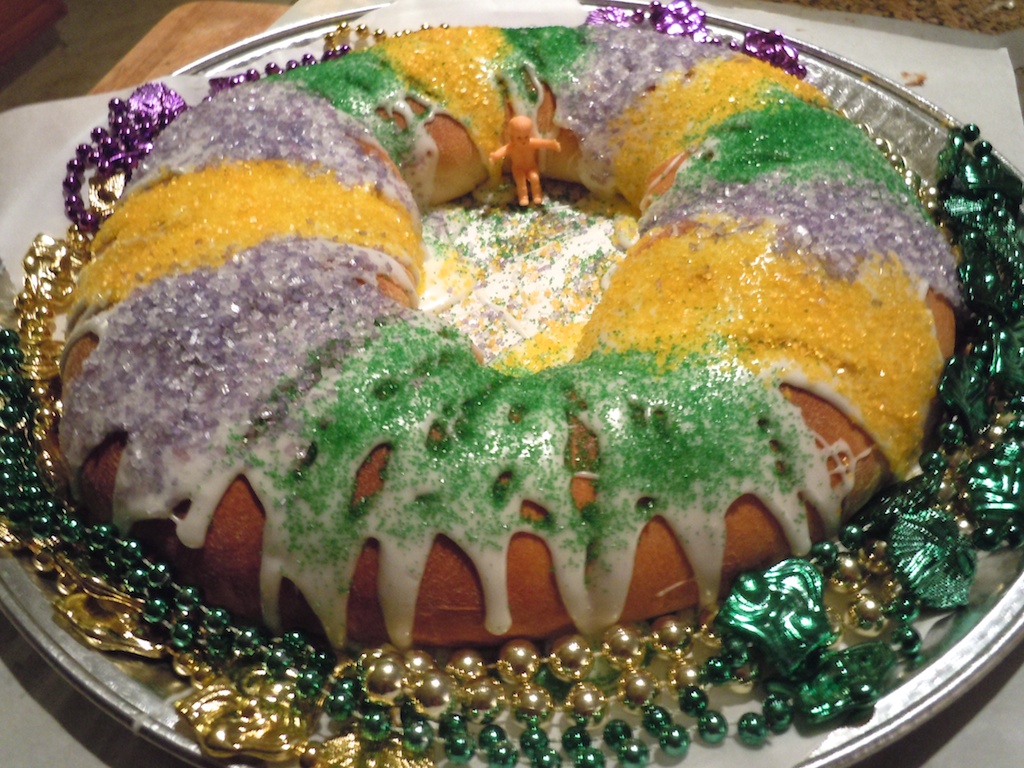 I came to know of King Cake because “I Was a Teenage Food Editor.†Actually, I was just a few years beyond teenage-dom when I was as the helm of a weekly food section at a Southern California newspaper, but I was certainly as inexperienced, naïve and pimply as any teen at the time.
I came to know of King Cake because “I Was a Teenage Food Editor.†Actually, I was just a few years beyond teenage-dom when I was as the helm of a weekly food section at a Southern California newspaper, but I was certainly as inexperienced, naïve and pimply as any teen at the time.
I will write more of this period of my life in a future entry, but you must know that I found my way into such a position through the hard work, chance and brazenness of being young and fearless and overconfident, of first being food editor of my college newspaper (yes, we had a food section…it was the late 1980s, and we took our newspapering quite seriously) and then post-college, landing an editorial fellowship with a national publication that brought me from Kansas to California. Following that internship, I wanted to stay in the Golden State, so I procured what I considered the most creative role at a newspaper – food editor.
When you are a food editor, people send you things, like samples of cereal and cans of cooking spray and yes, even vials of Beano, which was brand new at the time. They want you to try their stuff and write about it. Actually, this is what people must know about newspapers and magazines – people send such publications free stuff, expecting publicity. Payola. The journalist with integrity will resist. The shill will take and take and not feel a whiff of guilt whether writing or not writing about it. During the years I was a young journalist, I considered myself quite honorable and resisted as best I could, so my objectivity would not be compromised. But when I was sent a King Cake from New Orleans, I relented. How could I not? I was young, poor and terribly hungry.
The mysterious big box arrived just before Mardis Gras day, and when I opened it, I was nearly blinded by the twinkling of enough green, gold and purple sanding sugar to dust the length of Venice Beach. My newspaper colleagues – also poor and wafer-thin – had crowded around my desk in anticipation of free food and gasped at the opulence of the creature before them. It was certainly the most garish baked good I had ever seen, a bloated wreath somewhat repulsively laden with a thick coat of glaze to glue on all those Mardis Gras colors. We couldn’t take our eyes off of it. Then we dug in. Literature sent with the cake revealed that a small toy baby doll was hidden somewhere in the round. The cake was good – terribly sugary – a sweet-roll coffee cake of tender dough with a cinnamon-y filling. Our one meal of the day….and it was free.
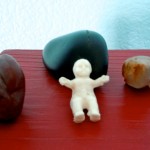 Guess who got the baby! Me! I was thrilled. Even at that young age, I always looked for signs. The meaning of finding the baby in your slice of cake was that you were now Queen (for a week, at least), and was said to be good luck and even indicated you might have a baby. It also meant you must bring a King Cake to the next gathering.
Guess who got the baby! Me! I was thrilled. Even at that young age, I always looked for signs. The meaning of finding the baby in your slice of cake was that you were now Queen (for a week, at least), and was said to be good luck and even indicated you might have a baby. It also meant you must bring a King Cake to the next gathering.
Well, I’ll just say, many moons have passed since that King Cake, and the only baby I have had (in human form, that is) is the one I got in that cake. I have it still, displayed with other small objects found and given significance over the years. And finally, this Mardis Gras, I fulfilled my destiny of making a King Cake and bringing it to a gathering. A full circle of sweet brioche dough with a cream cheese and pecan filling and colorfully cast with glaze and bold Mardis Gras colors.
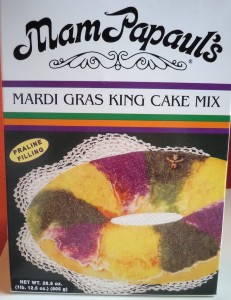 I could have made my cake from a kit – they are available, and I purchased one to try. Then I thought, I am A Woman Sconed, and King Cake is technically made of a bread dough, and by golly, bread-of-the month could certainly be one festive King Cake! But where would I find a baby? I couldn’t use mine, too precious. And I couldn’t extract one from the kit, leaving it infant-less. Look no further than Amazon for King Cake babies
I could have made my cake from a kit – they are available, and I purchased one to try. Then I thought, I am A Woman Sconed, and King Cake is technically made of a bread dough, and by golly, bread-of-the month could certainly be one festive King Cake! But where would I find a baby? I couldn’t use mine, too precious. And I couldn’t extract one from the kit, leaving it infant-less. Look no further than Amazon for King Cake babies, coming six to a pack.
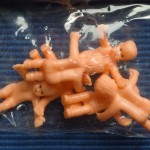
Before I proceed with the making of the cake, let me tell you of its history. King Cake or Twelfth Night Cake is a New Orleans tradition brought by French settlers who “continued a custom dating back to the Middle Ages,†according to “The New Orleans Cookbook†by Rima and Richard Collin (1975). The cakes are served between Twelfth Night (Jan. 6) and Ash Wednesday. They are traditionally made in the shape of a crown and decorated royally with sparkling sugars and candied fruit. A bean or a baby is either baked in the cake or pressed in following baking. The baby, according to my research, represents the Baby Jesus. The cake, from what I gather, represents one last hoopla of decadence before the start of Lent. Which makes Mardis Gras itself make a lot of sense.

AWS does not follow any traditional religion, but is curious about the customs and beliefs of all faiths. She is particularly intrigued by New Orleans and has vowed to get there soon. Part of her King Cake preparation is to put a mojo out there for a New Orleans trip. Last year, a dear friend brought her a requested voodoo doll from the Crescent City.  His mysterious demeanor and the dank funky smell of his cloak has only fueled her desire to get down South.
His mysterious demeanor and the dank funky smell of his cloak has only fueled her desire to get down South.
So, for this cake, I looked all over for recipes. I tend to gravitate toward certain resources, one of them being Saveur, the National Geographic of food magazines. Their King Cake recipe appealed to me for its cream cheese filling and a buttermilk glaze. Yum. If you were going to make something that glowed in the dark, it should at least taste good.
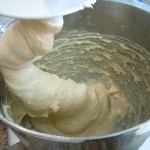 So, with dough hook in hand (on the stand mixer) I whipped up a brioche type dough (remember brioche? I’m no longer a-scared of it) made sweeter with both white and brown sugar, and made tender with eggs and butter. The dough was beaten for several minutes, and the mixer seemed to dance across the countertop to the beat of a voodoo drum.
So, with dough hook in hand (on the stand mixer) I whipped up a brioche type dough (remember brioche? I’m no longer a-scared of it) made sweeter with both white and brown sugar, and made tender with eggs and butter. The dough was beaten for several minutes, and the mixer seemed to dance across the countertop to the beat of a voodoo drum.
After the dough rose, it was rolled into a circle and a hole was made in the center.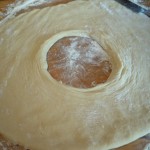 A filling made from cream cheese, cinnamon, brown sugar, maple syrup, lemon zest and pecans (tangy and not overly sweet), was spread around the circle, then the outer edges of the dough were rolled around the filling. Another raising and the cake was ready to bake. After viewing a few different instructions, I decided not to bake the plastic baby in the cake for fear of it melting (melted babies are no fun) – I would insert it afterwards.
A filling made from cream cheese, cinnamon, brown sugar, maple syrup, lemon zest and pecans (tangy and not overly sweet), was spread around the circle, then the outer edges of the dough were rolled around the filling. Another raising and the cake was ready to bake. After viewing a few different instructions, I decided not to bake the plastic baby in the cake for fear of it melting (melted babies are no fun) – I would insert it afterwards.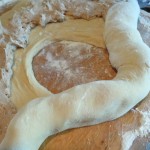
The ring baked up to a nice golden brown. The baby was inserted (head first!). The drizzle of buttermilk glaze provided the perfect foundation for the dusting of colorful sugar.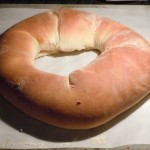
I took the cake to work and it was well-received by both the curious and the hungry. I put a warning sign about the baby next to the cake. No one was going to choke on this cake – not on my watch. I knew where the baby was, so I took myself out of the running.
But I did cut myself the first THIN slice to get the ball rolling. The cake was colorful, but thankfully, it was also good. I’d never made such a thing and was surprised by my success. A tender coffeecake made moister by the tang of spiced cream cheese and buttermilk glaze. The crunch of sugar added a sweet textural finish.
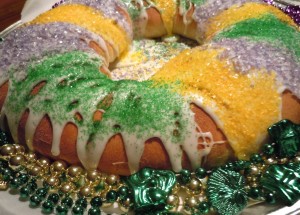 A delightful young fellow, enjoying a slice of the cake, suddenly looked at it. “There’s a baby in here,†he said calmly, then laughed. He wasn’t much older than I was when I got my baby. And he’d just had a birthday recently. He seemed worthy of being King. He took the baby to give to his girlfriend, and I gave him a King Cake kit so he could be the bearer of the sweet roll crown at a future occasion.
A delightful young fellow, enjoying a slice of the cake, suddenly looked at it. “There’s a baby in here,†he said calmly, then laughed. He wasn’t much older than I was when I got my baby. And he’d just had a birthday recently. He seemed worthy of being King. He took the baby to give to his girlfriend, and I gave him a King Cake kit so he could be the bearer of the sweet roll crown at a future occasion.
King Cake
From Saveur magazine
For The Dough:
1 1/4-oz. package active dry yeast
1/4 cup sugar
1/2 cup milk
2 tbsp. light brown sugar
1/2 tsp. vanilla extract
1 egg
1 egg yolk
2 3/4 cups flour
3/4 tsp. kosher salt
8 tbsp. softened butter
For the Filling:
1 lb. cream cheese
1/2 cup packed dark brown sugar
1/2 cup chopped pecans
2 tbsp. maple syrup
2 tsp. ground cinnamon
1/2 tsp. kosher salt
Zest of 1/2 lemon
For the Icing:
2 cups confectioners’ sugar
1/4 cup buttermilk
Green, purple, and yellow sanding sugars
1. Make the dough: In the bowl of a standing mixer fitted with a
hook, combine yeast, 1/2 tsp. of the sugar, and 1/4 cup water
heated to 115°. Stir to combine and let sit until foamy, about 10
minutes. Add remaining sugar, milk, light brown sugar, vanilla,
egg, and egg yolk. Beat on low speed until thoroughly combined, 1
minute. Turn mixer off and add flour and salt. Mix on medium
speed until the dough just comes together. Turn mixer speed to
high and knead dough for 4 minutes. Add the butter and continue
kneading until dough is smooth and pulls away from the side of the
bowl, about 6 minutes. Remove bowl from mixer, cover with
plastic wrap, and let sit until doubled in size, 1 1/2–2 hours.
2. Meanwhile, make the filling: Combine cream cheese, brown
sugar, pecans, cinnamon, salt, and zest in a large bowl and beat on
medium speed of a hand mixer until combined; set aside.
3. Punch down dough and turn it out onto a heavily floured
surface. Using a floured rolling pin, roll the dough into a large
circle, about 1/4″-thick. Cut a hole in the center of the circle and
pull with your fingers to widen. Place dollops of filling evenly
around circle halfway between outer edge and inner hole. Drape
outside edges over filling and continue rolling outside inward until
filling is covered, widening inner hole as needed, until dough
covers the seam. Transfer rolled dough circle to a parchment
paper-lined baking sheet; cover with plastic wrap and let sit for 1
hour. Heat oven to 350°. Uncover cake and bake until golden
brown, about 30 minutes. Let cool completely.
4. Make the icing: Whisk together the sugar and buttermilk in a
small bowl until smooth. Transfer king cake to a cutting board or
serving platter; spread icing evenly over top of cake and sprinkle
evenly with sanding sugars.